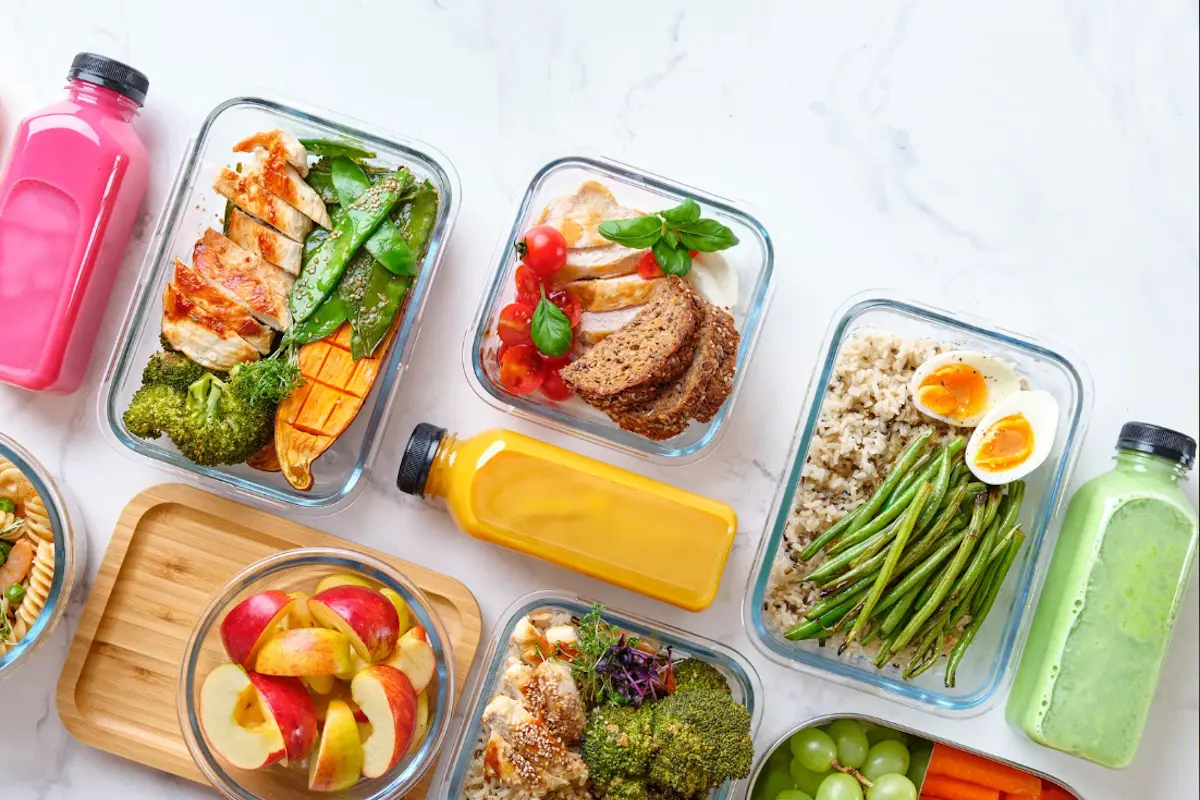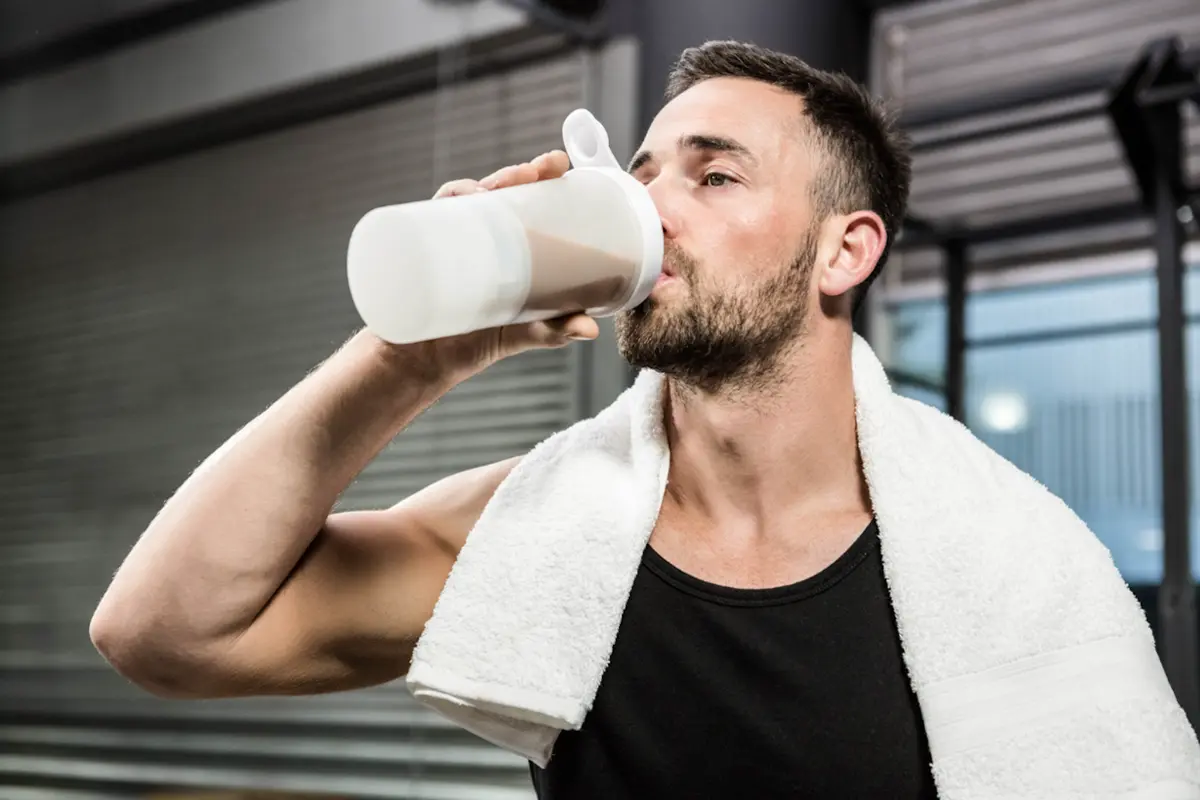Flexible Dieting for Strength Athletes

What's In This Article
- Key Takeaways
- Flexible Dieting For Strength Athletes
- Designing Your Flexible Meal Plan
- Food Choices with Flexibility
- The Science Behind Flexible Dieting and Strength Training
- Measuring Success Beyond the Scale
- Overcoming Challenges in Flexible Dieting
- Summary
- Frequently Asked Questions
- References
- Resources
Key Takeaways
- Flexible dieting is a customizable approach that enables strength athletes to meet their various body composition and weight management goals by tracking and balancing protein, carbohydrates, and fat intake. It promotes long-term sustainable nutrition over temporary fixes.
- Tailoring macronutrient ratios to individual strength goals is vital. Emphasizing a high protein intake for muscle growth and recovery while adjusting calorie consumption based on training cycles to optimize energy intake for performance is essential.
- Flexible dieting supports a varied diet, which includes controlled portions of favorite foods and aligns with macronutrient targets, offering dietary freedom that promotes better balance, satisfaction, and adherence.
Flexible Dieting For Strength Athletes
Imagine a diet that adapts to your needs, supports body transformation and weight management goals, and still allows you to indulge in your favorite foods.
Flexible dieting is a versatile approach that will enable you to customize your diet to meet your goals, whether losing fat, maintaining weight, or gaining muscle, based on your macronutrient intake.
Dr Grant Tinsley, lead author of a study on flexible dieting in resistance-trained individuals, endorses a flexible diet strategy as equally effective for weight loss during a caloric restriction diet compared to a rigid approach.
It provides the flexibility to adapt your diet to your specific needs and preferences. Flexible dieting comprises the three main macronutrients: protein, carbohydrates, and fat. Its adaptability supports various goals for strength athletes, such as body transformation and weight management.
The key to flexible dieting lies in the following:
- Disciplined meal planning
- Ensuring protein goals are met
- Understanding that it enables athletes to eat foods they enjoy while achieving their body composition goals
It’s not just about counting calories or losing weight; it’s about achieving a sustainable nutrition approach that fits your macros (IIFYM) and lifestyle. It’s about the freedom to make food choices that nourish your body and satisfy your taste buds without compromising your strength goals.
Dr. Layne Norton, a nutrition scientist and powerlifter, advocates for flexible dieting through macro tracking. He argues that this approach can help athletes maintain a balanced diet while still enjoying a variety of foods, which can lead to better long-term adherence to nutritional goals.

The Core Principles of Flexible Dieting
At its heart, flexible dieting focuses on:
- Tracking the consumption of grams of protein, carbohydrates, and fat based on individual needs
- Allowing you to enjoy a wide range of foods
- Still reaching your body composition goals
Dr. Mike Israetel, a sports nutrition expert and co-founder of Renaissance Periodization, emphasizes that tracking macros can lead to more precise nutrition planning. He states that this approach allows athletes to fine-tune their intake based on their specific goals: muscle gain, fat loss, or performance optimization.
One of the foundational principles of flexible dieting is the balance between nutritious and non-nutritious foods. It encourages eating foods one enjoys as long as most daily calories come from nutrient-dense foods. A successful flexible diet is about consuming a higher proportion of nutritious foods compared to non-nutritious foods.
It’s not about food restriction or rigid dietary control but about making smart food choices that align with your goals and the concept of an iifym diet, leading to a plan that is both enjoyable and effective.
The Concept of "If It Fits Your Macros"
Tailoring your macros to your strength goals is integral to flexible dieting. The optimal macronutrient ratios are determined using a percentage-based approach, assigning specific daily caloric intake percentages to carbohydrates, protein, and fat based on an individual’s strength-centric goals, reaping numerous health benefits.
For muscle gain and support during heavy lifting, a recommended:
- Protein intake is at least 1 gram of much protein per pound of desired body weight to help maintain lean body mass.
- This high protein intake can support muscle growth without necessarily leading to increased body fat.
The macro balance is highly individual and should be tailored considering specific goals, body composition, and activity level, with ongoing adaptability to ensure progress towards strength goals.
Beyond protein, fats are also vital for:
- maintaining cell membranes
- nerve fibers
- hormone production
- serving as a primary energy source in a resting state
All of these are crucial for athletes engaged in intense workouts. This highlights the importance of not overlooking any macronutrient in pursuing strength goals. Each macronutrient has a role in flexible dieting, and optimizing their balance is key to success.
Adapting Caloric Intake for Training Cycles
Adapting the amount of calories for training cycles is another critical aspect of flexible dieting. Olympic weightlifter Mattie Rogers has spoken about how macro tracking helped her maintain her weight class while optimizing her performance. It allowed her to fuel properly for intense training sessions while staying within the competition weight limit.
- Bodybuilders typically engage in an off-season (bulking phase) to build muscle, increasing calorie intake by about 15%, followed by an in-season (cutting phase) to lose fat, which involves decreasing calorie intake by about 15% from maintenance levels.
- Powerlifters usually cycle between competition prep and off-season; each phase has different calorie requirements.
- Powerlifters often consume more food and calories on more challenging training days to meet the increased energy demands of higher training loads. They adjust their energy intake by decreasing calorie consumption on lower volume or rest days and increasing it on days with more intense training.
While resistance training, avoiding severe caloric restriction is necessary.
- Ensuring adequate protein intake can help prevent adverse metabolic effects like decreased resting metabolic rate, often seen with weight loss diets.
- Crash diets that rapidly reduce calories can raise the risk of illness and injury and may harm an athlete’s training and recovery capacity.
- A recommended strategy for weight loss in athletes is to create a deficit of about 500 calories per day while avoiding eating fewer than 13.5 calories per pound of fat-free mass per day to prevent excessive restriction (Wu et al., 2024).
- This adaptive approach to energy balance is what makes flexible dieting a sought-after strategy among strength athletes.

Designing Your Flexible Meal Plan
Athletes need a flexible and personalized sports nutrition plan considering specific sports, goals, food preferences, nutritional needs and practical challenges. It’s about designing nutritious and sustainable meals while providing dietary enjoyment.
- Using apps like Myfitnesspal or a macro calculator is recommended to track daily macronutrient goals by logging your food intake, ensuring you meet your macro targets. This helps keep you on track with your dietary intake and makes it easier to adjust your meal plan as needed.
- Eating 4-5 times a day is suggested during regimes like the Brute Men Flexible Diet to meet daily macro goals better and prevent poor dietary choices due to hunger.
- Creating a flexible meal plan is not about strict dieting or deprivation. It’s about finding the right balance of macronutrients that fits your macros and supports your strength goals.
- It’s about enjoying the foods you love while fueling your body optimally. This is the essence of a personalized approach and the key to crafting a meal plan that powers your performance.
From Plate to Performance: Building Your Meals
Building your meals with a focus on whole foods, quality proteins, and unrefined carbohydrates is a fundamental part of flexible dieting.
For intense training, protein intake should be at least 0.9 grams per pound of body weight, with an increase to 1 gram per pound for those focusing on muscle gain. This high protein intake is essential in a flexible diet for muscle growth and can increase without necessarily leading to a rise in body fat.
Quality proteins should come from high-quality sources, including:
- Lean meats
- Poultry
- Fish
- Dairy
- Eggs
- Plants
Incorporating whole, non-processed foods and high-fiber vegetables and fruits can enhance meal satiety while providing key vitamins and minerals.
- Choosing carbohydrates based on the glycemic index and focusing on unrefined options like wholegrain bread ensures sustained energy for workouts.
- Including healthy fats supports hormone production and overall well-being.
- In flexible dieting, prioritizing nutrient-dense food choices is essential for optimal function, providing adequate fiber and a broad spectrum of vitamins and minerals.
A consistent ratio of macronutrients is maintained regardless of whether an athlete is bulking or cutting to ensure a sufficient intake of essential minerals and vitamins.

Timing is Everything: Nutrient Timing for Optimal Results
Nutrient timing is an aspect of flexible dieting that can significantly impact your training outcomes. Proper refueling with carbs and protein immediately after training aids recovery, especially during weight loss plateaus or intense training programs.
For muscle gain and recovery, consuming a protein-rich meal with carbohydrates for optimal carbohydrate intake within a few hours post-workout is recommended to maximize nutrient absorption. After intense training, consuming carbohydrates with a high glycemic index can enhance glycogen storage, assisting in effective recovery.
To optimize recovery post-workout, consume:
- 20-40 grams of protein
- 5 – 0.7 grams of carbs per pound of body weight for muscle rebuilding and glycogen restoration
- 1 gram of carbs per kilogram of bodyweight post-workout to aid in proper recovery and maintain sports performance
In addition to post-workout nutrition, pre-workout nutrition is equally vital.
- 30 to 50 grams of carbohydrates are recommended before a workout to prepare the body for physical activity.
- High-quality protein, 30 to 40 grams, should be consumed before and after workouts to support muscle anabolism.
Supplementing for Success
Supplements can support a flexible diet for muscle growth and recovery.
- Whey protein is recommended for muscle recovery due to its easy digestion, absorption, and rich essential amino acid content.
- Whey protein post-workout and casein before sleep are advantageous for continuous recovery.
Beyond protein supplements, several other supplements can contribute to muscle recovery. These include:
- Branched-chain amino acids (BCAAs), which promote muscle growth, reduce fatigue, and ease soreness
- Tart cherry juice extract, which reduces muscle inflammation and post-exercise pain
- Medium-chain triglycerides (MCTs), which provide energy
- Omega-3 fatty acids, which reduce inflammation
- Creatine, which enhances nutrient delivery to muscles
- Citrulline malate, which improves recovery and performance
While supplements can be beneficial, they should not replace a balanced diet. A well-rounded diet focusing on whole foods should remain the foundation of nutrition for strength training. Supplements may be integrated as a secondary measure to enhance dietary completeness.

Food Choices with Flexibility
Navigating food choices with flexibility is one of the key benefits of healthy eating through flexible dieting. Nutrient-dense foods, like vegetables, lean proteins, and whole grains, should form most of the daily caloric intake in flexible dieting. But it also allows for controlled portions of less nutrient-dense foods, promoting better balance and satisfaction.
- Flexible dieting encourages a variety of food choices by focusing on macronutrient targets and a high protein intake, which may enhance dietary freedom and long-term adherence for strength athletes.
- This dietary freedom means enjoying your favorite foods in moderation without feeling guilty or compromising your strength goals, unlike the strict dieting of bodybuilders who may have more limited options.
- Allowing for occasional indulgences within a flexible diet can help optimize body composition by preventing the cravings and binge eating behaviors common in more restrictive diets.
- This balance of dietary discipline and freedom makes flexible dieting a sustainable and enjoyable approach to nutrition.
Eating Out Without Straying Out
Eating out can often pose a challenge for those following a strict diet. However, with flexible dieting, you can enjoy a meal out without straying from your dietary goals.
Here are some tips for healthier choices:
- Order first to prevent being influenced by the unhealthy choices of companions.
- To manage calorie intake when eating out, opt for smaller portions by ordering two appetizers instead of a main course or sharing a meal.
- When faced with a buffet, use a smaller plate to help control portion sizes, and fill at least half of it with salad or vegetables to increase fiber and nutrient intake.
- Ask for sauces and dressings on the side to control your consumption and reduce extra fat and calories from your meal.
- Decline pre-meal snacks like bread or chips to prevent additional calorie intake.
- Choose cooking methods such as steaming, grilling, roasting, or poaching over frying to reduce calorie intake while eating out.
- Eating slowly and chewing thoroughly can help you eat less and feel sated more quickly in restaurant settings.
Snack Smart: On-the-Go Nutrition
With a busy schedule and multiple training sessions, nutrient-rich snacks must be handy.
- Prioritize nutrient-rich, whole-food snacks over processed foods to improve body composition and overall health. Eating multiple times a day helps with sticking to a flexible diet and prevents poor food choices due to extreme hunger.
- Meal prepping snacks in advance supports consistent adherence to the flexible diet macro goals. By preparing your snacks in advance, you can ensure that you always have a healthy and satisfying option, no matter where your day takes you.
Having a variety of snacks to choose from can also make your diet more enjoyable and sustainable. Try experimenting with different combinations of:
- Fruits
- Nuts
- Seeds
- Protein-rich foods like skyr

The Science Behind Flexible Dieting and Strength Training
The science behind flexible dieting and strength training is fascinating and provides a solid foundation for this approach to nutrition. Professor Mark Haub’s experiment demonstrated that caloric balance primarily influences weight management.
He was able to lose 27 pounds by consuming fewer calories than his body expended despite the food sources being essentially junk food. This suggests that the source of calories is less critical than the number of calories when it comes to weight management.
Body Composition Breakthroughs
Regarding strength training, body composition is often a more relevant measure of progress than body weight. Research such as Carbone and Pasiakos's 2019 paper supports:
- The efficacy of a high protein intake for muscle gain, even when other macronutrients are not restricted, plays a key role in flexible dieting strategies.
- A diet with a high protein content combined with resistance training and a caloric deficit can increase lean muscle mass while reducing fat mass compared to lower-protein diets.
Conlin et al. 2021 studied 23 resistance-trained participants who completed a 20-week intervention consisting of a 10-week diet phase followed by a 10-week post-diet phase. Participants were randomized into flexible diet (FLEX) and rigid diet (RIGID) groups.
- During the post-diet phase, the flexible dieting group gained significantly more fat-free mass than the rigid dieting group.
- The flexible group gained 1.7kg of fat-free mass during the post-diet phase, while the rigid group only gained 0.7kg.
- The flexible group gained no fat mass during the post-diet phase, while the rigid group gained 1.1kg.
Maintaining a moderate caloric deficit with a high protein intake allows resistance-trained individuals to possibly preserve or even gain fat-free mass, which benefits body composition during weight loss regimens.
Resistance Training and Energy Expenditure
Energy balance and macronutrient distribution are crucial in resistance training and metabolic adaptations. The Total Daily Energy Expenditure (TDEE) calculation is central to aligning strength training with dietary freedom. A TDEE calculator works out :
- Basal metabolic rate (BMR)
- The thermic effect of food
- Non-exercise activity thermogenesis
- Exercise activity thermogenesis, which adjusts for various levels of physical activity.
The thermic effect of food plays a critical role in energy expenditure as it requires the body to use more energy to digest certain macronutrients, like protein from animal sources and fibrous vegetables, thus impacting total calorie burn and supporting the utility of macronutrient counting over just tracking calorie intake.
Studies such as Wu et al.'s 2024 research show that dieting strategies maintain resting metabolic rates provided caloric restriction is moderate and accompanied by training, thus suggesting that metabolic adaptations are minimal.
By understanding the science behind energy expenditure and resistance training, you can better tailor your flexible diet to support your training goals. It’s about understanding how your body uses energy and how you can optimize this process to fuel your workouts and recover effectively.

Measuring Success Beyond the Scale
For strength athletes, success is often measured in more ways than just numbers on the scale. The scale may not always reflect body composition improvements because flexible dieting encourages building muscle while losing fat. Hence, it’s crucial to consider other metrics when tracking progress.
Valuable metrics for tracking fitness progress in strength athletes include:
- Body composition testing is key in accurately measuring the body’s fat and muscle percentages, which is essential for distinguishing fat loss from muscle gain.
- Workout and competition performance
- Subjective indicators like appearance and energy levels
Consistent body composition measurements taken ideally every 2-4 weeks can reveal progress, pinpoint areas for improvement, and guide training and nutrition alterations.
The Role of the Three-Factor Eating Questionnaire in Diet Adherence
The Three Factor Eating Questionnaire (TFEQ) plays a significant role in assessing eating behaviors that influence diet adherence.
- The TFEQ assesses three dimensions of eating behavior: cognitive restraint of eating, disinhibition, and hunger. These dimensions can provide valuable insights into your eating habits and help guide sustainable changes.
- The TFEQ identifies behavioral patterns that influence diet adherence, including the tendency to overeat due to external cues (disinhibition) and the level of voluntary control over eating (restraint).
- Understanding these patterns can provide insights into the barriers hindering your progress and help you develop strategies to overcome them.
- Insights gained from the TFEQ about personal eating habits can help strength athletes make sustainable changes to improve adherence to their diet plans.
Adjusting Your Caloric Deficit or Surplus
Adjusting your caloric intake based on progress and goals is integral to flexible dieting.
- The flexible dieting approach emphasizes the importance of energy balance, with weight loss requiring a calorie deficit and muscle growth usually requiring a calorie surplus. This energy intake and expenditure balance is key to achieving your strength goals.
- Adjusting caloric intake is essential for strength athletes to maintain or increase lean body mass while reducing fat.
- It’s necessary to recalculate Total Daily Energy Expenditure (TDEE) periodically, especially after significant changes in weight or activity level, to ensure caloric intake aligns with current needs.
- Athletes should closely monitor fat and lean body mass changes to ensure that caloric adjustments support muscle preservation during weight loss.
- After achieving a body fat percentage goal, gradually increasing calorie intake can help minimize weight regain and restore metabolic function.

Overcoming Challenges in Flexible Dieting
Overcoming challenges in flexible dieting involves:
- Balancing strict dieting with dietary freedom
- Implementing strategies to deal with plateaus and setbacks
- Adherence to a flexible dieting approach is essential for sustainable improvements in body composition over time
- Flexible dieting allows for a dietary pattern that is realistic and enjoyable, facilitating long-term maintenance.
In flexible dieting, it’s essential to:
- Forgive dietary lapses
- Plan for minor setbacks
- Maintain a positive attitude
- Stay committed to your flexible dieting plan
Balancing Strict Dieting and Dietary Freedom
- Balancing strict dieting and dietary freedom is an art in flexible dieting, accommodating personal preferences for long-term adherence.
- Enjoy your favorite foods while meeting macro targets, supporting resistance training and possibly weight loss without overeating.
- Flexibility in food choices promotes better health and weight management.
- Find the balance between discipline and freedom to make progress towards strength goals.
Dealing with Plateaus and Setbacks
You can implement strategies to overcome these obstacles and continue making progress. Implementing behavioral strategies such as:
- Accurately recording food portions
- Staying well-hydrated
- Consuming meals slowly
- Avoiding excessive alcohol
- Ensuring adequate sleep
- Managing stress
Setbacks are a normal part of any fitness journey, and how you respond to them can significantly impact your progress. By maintaining a positive attitude and staying committed to your flexible dieting plan, you can overcome these challenges and continue moving towards your strength goals.
Summary
Flexible dieting can be revolutionary for strength athletes, focusing on macronutrient balance over caloric restriction. It offers a sustainable, enjoyable approach to nutrition. It's about enjoying various foods while achieving body composition and strength goals.
From unlocking your potential to crafting meal plans, understanding the science behind it, and tracking progress, flexible dieting supports strength training effectively. It's a lifestyle promoting dietary freedom, balanced nutrition, and sustainable results for athletes at all levels.
Frequently Asked Questions
Can you build muscle with a flexible diet?
Yes, flexible dieting allows you to build lean muscle while incorporating a variety of balanced meals and food items in moderation. This approach emphasizes macronutrients and can transform your physique.
Why is it important to provide flexibility in an athlete's diet?
Dietary flexibility helps athletes maintain good nutrition while adapting to training schedules, travel, and competition demands. It prevents stress around rigid meal plans, allows for cultural preferences, and makes long-term adherence easier. This supports both athletic performance and mental well-being.
What is the flexible dieting approach?
Flexible dieting is an approach that involves counting and measuring foods to control calorie intake and macronutrients. It originated in the bodybuilding industry and focuses on controlling body composition and muscle presentation.
What is the difference between intuitive eating and flexible dieting?
Intuitive eating relies on internal hunger and satiety cues, while flexible dieting relies on external cues for eating and portion control. Intuitive eating leads to lower psychological distress and higher psychological adjustment, whereas flexible dieting is more closely related to rigid control.
References
- Carbone, J. W., & Pasiakos, S. M. (2019). Dietary protein and muscle mass: Translating science to application and health benefit. Nutrients, 11(5), 1136.
- Conlin, L. A., Aguilar, D. T., Rogers, G. E., & Campbell, B. I. (2021). Flexible vs. rigid dieting in resistance-trained individuals seeking to optimize their physiques: A randomized controlled trial. Journal of the International Society of Sports Nutrition, 18, 52.
- Wu, X., Zhang, C., Liang, Z., Liang, Y., Li, Y., & Qiu, J. (2024). Exercise combined with a low-calorie diet improves body composition, attenuates muscle mass loss, and regulates appetite in adult women with high body fat percentage but normal BMI. Sports, 12(4), 91.
Resources